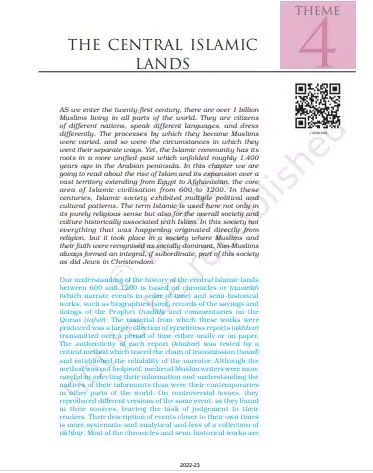‘NCERT Solutions for Class 11 History Chapter 4 The Central Islamic Lands‘ PDF Quick download link is given at the bottom of this article. You can see the PDF demo, size of the PDF, page numbers, and direct download Free PDF of ‘Ncert Class 11 History Chapter 4 Exercise Solution’ using the download button.
The Central Islamic Lands Textbook With Solution PDF Free Download

Chapter 4: The Central Islamic Lands
During 612-32, the Prophet Muhammad preached the worship of a single God, Allah, and the membership of a single community of believers (umma).
This was the origin of Islam. Muhammad was an Arab by language and culture and a merchant by profession.
Sixth-century Arab culture was largely confined to the Arabian peninsula and areas of southern Syria and Mesopotamia.
The Arabs were divided into tribes* (qabila), each led by a chief who was chosen partly on the basis of his family connections but more for his personal courage, wisdom and generosity (murawwa).
Each tribe had its own god or goddess, who was worshipped as an idol (sanam) in a shrine.
Many Arab tribes were nomadic (Bedouins), moving from dry to green areas (oases) of the desert in search of food (mainly dates) and fodder for their camels. Some settled in cities and practised trade or agriculture.
Muhammad’s own tribe, Quraysh, lived in Mecca and controlled the main shrine there, a cube-like structure called Kaba, in which idols were placed.
Even tribes outside Mecca considered the Kaba holy and installed their own idols at this shrine, making annual pilgrimages (hajj) to the shrine. Mecca was located on the crossroads of a trade route between Yemen and Syria which further enhanced the city’s importance (see Map p. 82).
The Meccan shrine was a sanctuary (haram) where violence was forbidden and protection given to all visitors. Pilgrimage and commerce gave the nomadic and settled tribes opportunities to communicate with one another and share their beliefs and customs.
Although the polytheistic Arabs were vaguely familiar with the notion of a Supreme God, Allah (possibly under the influence of the Jewish and Christian tribes living in their midst), their attachment to idols and shrines was more immediate and stronger.
Around 612, Muhammad declared himself to be the messenger (rasul) of God who had been commanded to preach that Allah alone should be worshipped.
The worship involved simple rituals, such as daily prayers (salat), and moral principles, such as distributing alms and abstaining from theft.
Muhammad was to found a community of believers (umma) bound by a common set of religious beliefs.
The community would bear witness (shahada) to the existence of the religion before God as well as before members of other religious communities. Muhammad’s message particularly appealed to those Meccans who felt deprived of the gains from trade and religion and were looking for a new community identity.
Those who accepted the doctrine were called Muslims. They were promised salvation on the Day of Judgement (qiyama) and a share of the resources of the community while on earth.
The Muslims soon faced considerable opposition from affluent Meccans who took offence to the rejection of their deities and found the new religion a threat to the status and prosperity of Mecca. In 622, Muhammad was forced to migrate with his followers to Medina.
Muhammad’s journey from Mecca (hijra) was a turning point in the history of Islam, with the year of his arrival in Medina marking the beginning of the Muslim calendar.
| Author | NCERT |
| Language | English |
| No. of Pages | 27 |
| PDF Size | 3.8 MB |
| Category | History |
| Source/Credits | ncert.nic.in |
NCERT Solutions Class 11 History Chapter 4 The Central Islamic Lands
Question 1.
What were the features of the lives of the Bedouins in the early seventh century?
Answer:
The Bedouins were Arab tribes. The main features of their lives are as follows:
- They led a nomadic life.
- They were indulged in looting, plundering and internal quarrels.
- They were camel pastoralists and moved with their animals from oases to oases.
- Date-palm and camel milk were their main diet.
- Their social organisation was based on independent tribes.
Question 2.
What is meant by the term ‘Abbasid revolution’?
Answer:
The term ‘Abbasid revolution’ refers to the Dawa Movement initiated by Abu Muslim from Khurasan against the Umayyad dynasty. This revolution put an end to the Umayyad dynasty, which ruled from 661 to 750. With the fall of Umayyad dynasty in 750, the Abbasid came to power and ruled till 1258.
Question 3.
Give examples of the cosmopolitan character of the states set up by Arabs, Iranians and Turks.
Answer:
Examples of the cosmopolitan character of the states set up by Arabs, Iranians and Turks:
- The vast Arab empire was inhabited by the people of multi cultural identities, i.e. the Muslims, the Christians and the Jews.
- The Iranian empire witnessed for the development of Muslim and Asian culture.
- In Turkish empire, the Egyptian, Iranian, Syrian and Sudanian culture developed simultaneously.
NCERT Class 11 History Textbook Chapter 4 The Central Islamic Lands With Answer PDF Free Download
